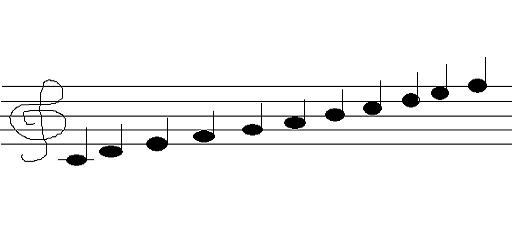Reading Piano Sheet Music: The Lines and the Spaces
Source:Internet Posted by:Learntopianoonline.com Date:2009-12-24 Click:
Reading Music: The Lines and the Spaces
Your first experience with playing music from written notations will come as soon as you
learn the notes. The first thing you have to do is to learn about the lines and the spaces
of the staffs. On the diagram below, the notes used are all quarter notes. That refers
to the rhythm of the notes which will be discussed later. The purpose of this diagram is
to show you the notes as they are positioned on the staff.
Treble C D E F G A B C D E F

--Figure B--
If you look just at the actual lines of the staff, you will see that they are, going up,
E-G-B-D-F. Some people remember this with little sayings, like “Every Good Boy Does
Fine.” There are memory tricks for all the lines and spaces on both staffs. For the
spaces of the treble clef, you will notice that the letters of the notes spell F-A-C-E.
Now, you can relate the notes on the page to the keys on the keyboard. Remember
where the middle C is? The C on the left of the diagram above depicts middle C. The
middle C is shown on an added line below the treble clef or above the bass clef. Using
middle C as a reference point and your new knowledge of the letters that go with the
notes, try to look at each note and then play the key it refers to.
Take the music you have at hand, and try to pick out a few notes on the piano from the
treble clef. You might even be able to play a melody line by using this method. This
will only get you started. However, every time you can have the satisfying experience
of playing music, you should take it. The feeling will carry you on to want to learn more.
There are more notes to learn on the bass clef. A diagram of the bass clef with the
notes on the lines and spaces is shown below.
Bass G A B C D E F G A B C

--Figure C--
On this diagram, the middle C is shown on the far right, which would be the end of this
short piece of music. The lines of the bass clef are G-B-D-F-A. Many people turn the
treble clef saying around and use the saying “Good Boys Do Fine Always.” The spaces
are A-C-E-G. One popular mnemonic device for this is, “All Cows Eat Grass.” Feel free
to make up anything that will help you to remember. Write your sayings down and
memorize them.
Another thing to learn is the notation for sharps and flats. This is the sign for a sharp: #.
It is placed to the left of the note. The flat is a totally different sign. It looks something
like a small letter b that has been squeezed until the circle looks almost like a half of a
heart shape. It is also put on the left side of a note. Look through your printed music
for any sharps and flats you might recognize.
Do not worry about the rhythm at this point. Take your written music and play as many
notes as you can from it. Say the note names as you play at first. This will get you in
the habit of thinking about the written note as a musical sound with a letter name.
Associating the three aspects of a note together will help you become more proficient at
reading music.
Buy some staff paper or make your own. You can make staff paper by drawing five
straight horizontal lines across the page, leaving a space, and then drawing five more
horizontal lines. Now you can draw some notes to play simple strings of notes.
Draw a note by making a filled in circle either on a line or in a space. Then, draw a line
up from it on the right. Make notes on different lines and in different spaces. Set aside
your pencil and try playing your notes. You should be able to look at the note you have
drawn and think of the letter name and the physical piano key it belongs to. Pretty
soon, you will be playing all the notes you can write. If it comes naturally to you, you
might start coming up with music you enjoy listening to as you write your notes.
When you have learned all about the lines and spaces, you will be well on your way to
understanding written music. The next step is to understand how chords are written.
Chords are notes that are played simultaneously.
You will recognize chords on the sheet music because they are written in a vertical line.
If they are quarter notes, as the notes in the previous diagrams are, they will share the
line that goes along the side of the note. There will be more on chords later. For now,
just take a look at how they are shown.
Try to play some chords as they are on your written music. You may have to place one
finger on a note at a time when you are first learning, but eventually you will see the
chord and your fingers will go into that position. Do a little practice with chords and get
ready to learn about rhythm.
Prev:Reading Music Introduction Next:Written Piano Music and Rhythm Part 1
